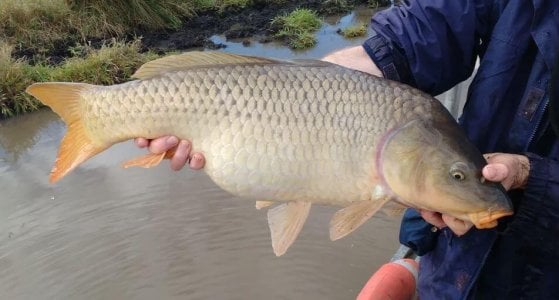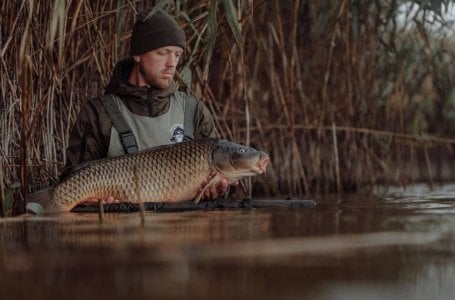Alert: Australia's Rivers in Peril from Invasive Danger – What You Need To Know
- Replies 9
As Australian rivers swell to dangerous heights in the wake of severe flooding, an unwelcome guest has followed the floodwaters into hundreds of kilometres of rivers and waterways.
It’s hard to fathom just how much devastation can be caused in a very short amount of time, so, here’s what you need to know.
Thousands of kilometres of Australian rivers are congested with a record number of invasive carp that are stirring up nutrients, muddying waters, and displacing native marine life.
Due to the severe flooding, the Murray-Darling Basin has seen a carp-breeding surge so rampant that the species now accounts for 90 per cent of the fish found in some waterways. In some videos uploaded on social media, the green water can be seen filled with the dark bodies of carp swimming near the surface of the water.
You can watch one of these videos below:
Dr Ivor Stuart, a Senior Scientist at the Arthur Rylah Institute and Fisheries Ecologist at Charles Sturt University, said that conditions are now worse than during the 2010 and 2016 floods.
‘I’ve been working in the field for 30 years, and there have been some bad years. But this is the worst I’ve seen,’ he claimed.
According to Mr Stuart, carp are a pest in Australia as they cause dramatic ecological damage both here and in many countries. In previous years, there have been estimates of up to 357 million carps during flood conditions.
This year, these numbers may have exceeded.
Carp are following water downriver and into floodplains, where they breed and survive in high numbers. It was reported that they head into the rivers when they’re running out of food and are ‘starving to death’.
The Murrumbidgee, Darling, and Macquarie Rivers are the worst affected because it is where floodplain litter has settled and is making the waters nutrient-rich. And despite their already-booming numbers, the carp are still expanding their territory.
The impacts of carp, according to the scientist, are like a ‘house of horrors’ for Australian rivers. The species cause massive degradations of aquatic plants, riverbanks, and riverbeds when they feed. This alters the habitat for small native fish, such as the southern pygmy perch.
This feeding behaviour contributes to muddled rivers, reducing sunlight penetration, and lessening productivity for native plants and other aquatic communities. And since carp directly modify their environment, this leads to the destruction of aquatic waterways.
Dr Stuart shared that although scientists have been successful in destroying them in Tasmania, they are still thriving on the mainland. He warned that they could spread into the tropics, the Snowy Mountains’ pristine mountain streams, and some new parts of WA.
Concerned communities are wondering if it’s time to unleash the carp herpes virus to control the population. Cyprinid herpesvirus 3 is a biological control method that was part of the federal government’s 2022 National Carp Control Plan that would cost an estimated $190 million to implement.
According to the mathematical modelling of the bio-control method, the carp virus could cause a 40 to 60 per cent decrease in carp population for at least 10 years. This could help tip the balance in favour of native fish.
However, the report does not explicitly endorse releasing the virus to control populations. It only outlines the steps that would be required before the virus is released.
Further research must be undertaken to prove the efficacy of this method and its impact on water quality for communities nearby. Other concerns included cleaning up dead carp, and potential significant reductions of water quality and native fish.
But how else can the carp population be managed?
Dr Stuart said that if the goal is reducing carp numbers and its impacts in the long run, then it is important to examine the roles humans play in supporting them.
The scientist then gave an example to support his claim. ‘The series of weir pools in the lower Murray create perfect conditions for carp because they give fish access to floodplains year-round,’ he started.
Dr Stuart added: ‘Strategically lowering and removing weir pools to re-create flowing water habitats would be one solution to help Murray cod and other flowing water specialists, such as silver perch, river snails and Murray crays. This is one of many integrated actions that could help tip the balance against carp.’
Another pathway he found was to seek guidance from ‘sophisticated environmental modelling’ that identifies the optimal population trajectory for native fish. Additionally, floods carry a huge potential for increases in the numbers of golden perch, frogs, yabbies, and water birds. ‘Animals that eat carp should all be as fat as they can be.’
 Did you know that carp can cause this much damage to marine wildlife? Share your thoughts about Dr Stuart’s findings in the comments below!
Did you know that carp can cause this much damage to marine wildlife? Share your thoughts about Dr Stuart’s findings in the comments below!
It’s hard to fathom just how much devastation can be caused in a very short amount of time, so, here’s what you need to know.
Thousands of kilometres of Australian rivers are congested with a record number of invasive carp that are stirring up nutrients, muddying waters, and displacing native marine life.
Due to the severe flooding, the Murray-Darling Basin has seen a carp-breeding surge so rampant that the species now accounts for 90 per cent of the fish found in some waterways. In some videos uploaded on social media, the green water can be seen filled with the dark bodies of carp swimming near the surface of the water.
You can watch one of these videos below:
Dr Ivor Stuart, a Senior Scientist at the Arthur Rylah Institute and Fisheries Ecologist at Charles Sturt University, said that conditions are now worse than during the 2010 and 2016 floods.
‘I’ve been working in the field for 30 years, and there have been some bad years. But this is the worst I’ve seen,’ he claimed.
According to Mr Stuart, carp are a pest in Australia as they cause dramatic ecological damage both here and in many countries. In previous years, there have been estimates of up to 357 million carps during flood conditions.
This year, these numbers may have exceeded.
Carp are following water downriver and into floodplains, where they breed and survive in high numbers. It was reported that they head into the rivers when they’re running out of food and are ‘starving to death’.
The Murrumbidgee, Darling, and Macquarie Rivers are the worst affected because it is where floodplain litter has settled and is making the waters nutrient-rich. And despite their already-booming numbers, the carp are still expanding their territory.
The impacts of carp, according to the scientist, are like a ‘house of horrors’ for Australian rivers. The species cause massive degradations of aquatic plants, riverbanks, and riverbeds when they feed. This alters the habitat for small native fish, such as the southern pygmy perch.
This feeding behaviour contributes to muddled rivers, reducing sunlight penetration, and lessening productivity for native plants and other aquatic communities. And since carp directly modify their environment, this leads to the destruction of aquatic waterways.
Dr Stuart shared that although scientists have been successful in destroying them in Tasmania, they are still thriving on the mainland. He warned that they could spread into the tropics, the Snowy Mountains’ pristine mountain streams, and some new parts of WA.
Concerned communities are wondering if it’s time to unleash the carp herpes virus to control the population. Cyprinid herpesvirus 3 is a biological control method that was part of the federal government’s 2022 National Carp Control Plan that would cost an estimated $190 million to implement.
According to the mathematical modelling of the bio-control method, the carp virus could cause a 40 to 60 per cent decrease in carp population for at least 10 years. This could help tip the balance in favour of native fish.
However, the report does not explicitly endorse releasing the virus to control populations. It only outlines the steps that would be required before the virus is released.
Further research must be undertaken to prove the efficacy of this method and its impact on water quality for communities nearby. Other concerns included cleaning up dead carp, and potential significant reductions of water quality and native fish.
But how else can the carp population be managed?
Dr Stuart said that if the goal is reducing carp numbers and its impacts in the long run, then it is important to examine the roles humans play in supporting them.
The scientist then gave an example to support his claim. ‘The series of weir pools in the lower Murray create perfect conditions for carp because they give fish access to floodplains year-round,’ he started.
Dr Stuart added: ‘Strategically lowering and removing weir pools to re-create flowing water habitats would be one solution to help Murray cod and other flowing water specialists, such as silver perch, river snails and Murray crays. This is one of many integrated actions that could help tip the balance against carp.’
Another pathway he found was to seek guidance from ‘sophisticated environmental modelling’ that identifies the optimal population trajectory for native fish. Additionally, floods carry a huge potential for increases in the numbers of golden perch, frogs, yabbies, and water birds. ‘Animals that eat carp should all be as fat as they can be.’
Key Takeaways
- Thousands of kilometres of Australian rivers are clogged with unprecedented numbers of invasive carp due to the severe flooding in the Murray-Darling Basin.
- The carp are stirring up nutrients, muddying waters and displacing native species.
- Scientists will need to use multiple techniques to help reduce their numbers, such as bio-control methods.










